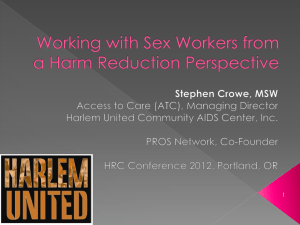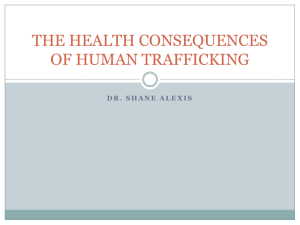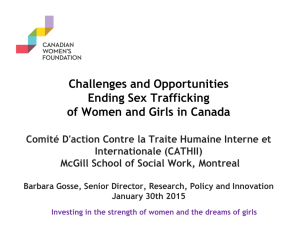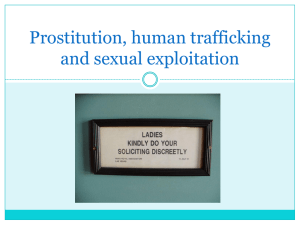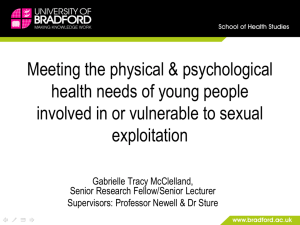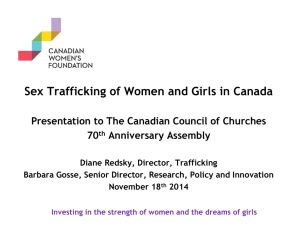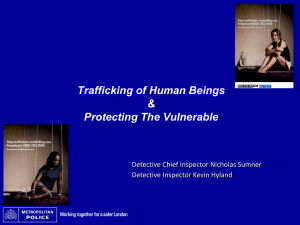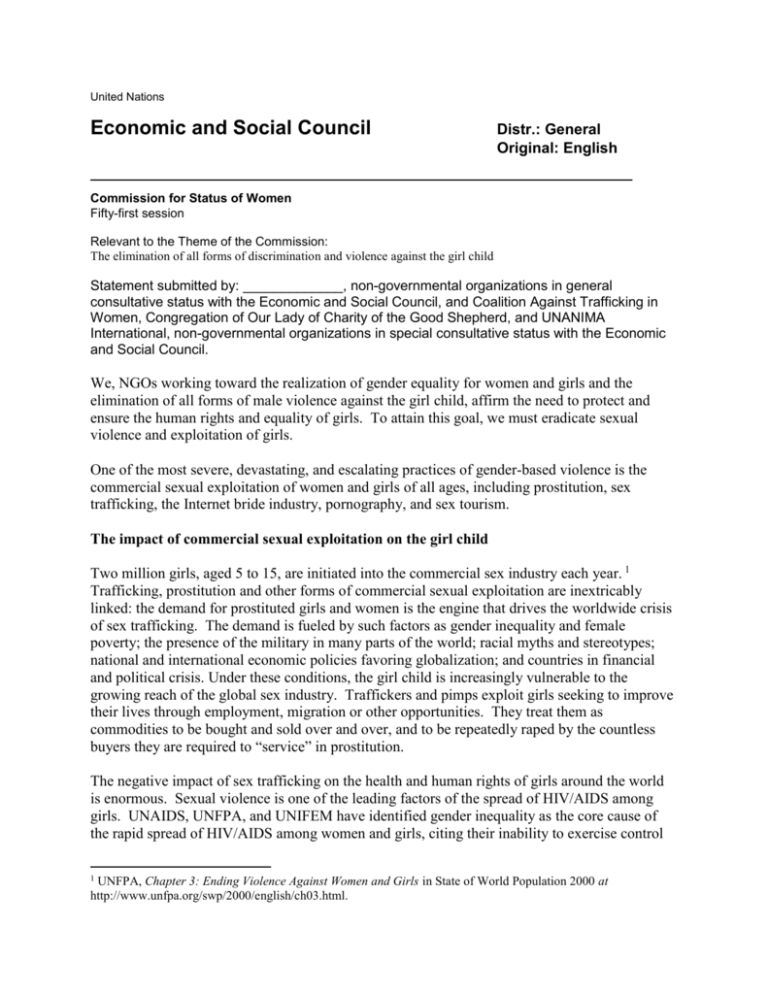
United Nations
Economic and Social Council
Distr.: General
Original: English
Commission for Status of Women
Fifty-first session
Relevant to the Theme of the Commission:
The elimination of all forms of discrimination and violence against the girl child
Statement submitted by: _____________, non-governmental organizations in general
consultative status with the Economic and Social Council, and Coalition Against Trafficking in
Women, Congregation of Our Lady of Charity of the Good Shepherd, and UNANIMA
International, non-governmental organizations in special consultative status with the Economic
and Social Council.
We, NGOs working toward the realization of gender equality for women and girls and the
elimination of all forms of male violence against the girl child, affirm the need to protect and
ensure the human rights and equality of girls. To attain this goal, we must eradicate sexual
violence and exploitation of girls.
One of the most severe, devastating, and escalating practices of gender-based violence is the
commercial sexual exploitation of women and girls of all ages, including prostitution, sex
trafficking, the Internet bride industry, pornography, and sex tourism.
The impact of commercial sexual exploitation on the girl child
Two million girls, aged 5 to 15, are initiated into the commercial sex industry each year. 1
Trafficking, prostitution and other forms of commercial sexual exploitation are inextricably
linked: the demand for prostituted girls and women is the engine that drives the worldwide crisis
of sex trafficking. The demand is fueled by such factors as gender inequality and female
poverty; the presence of the military in many parts of the world; racial myths and stereotypes;
national and international economic policies favoring globalization; and countries in financial
and political crisis. Under these conditions, the girl child is increasingly vulnerable to the
growing reach of the global sex industry. Traffickers and pimps exploit girls seeking to improve
their lives through employment, migration or other opportunities. They treat them as
commodities to be bought and sold over and over, and to be repeatedly raped by the countless
buyers they are required to “service” in prostitution.
The negative impact of sex trafficking on the health and human rights of girls around the world
is enormous. Sexual violence is one of the leading factors of the spread of HIV/AIDS among
girls. UNAIDS, UNFPA, and UNIFEM have identified gender inequality as the core cause of
the rapid spread of HIV/AIDS among women and girls, citing their inability to exercise control
1
UNFPA, Chapter 3: Ending Violence Against Women and Girls in State of World Population 2000 at
http://www.unfpa.org/swp/2000/english/ch03.html.
over their bodies and their lives. Demand for prostitution and other forms of commercial sexual
exploitation of girls increases with the buyers’ belief that younger girls are less likely to be
infected with HIV and other sexually transmitted diseases. Victims of prostitution often suffer
severe health consequences including physical injuries from beatings, rapes, and unwanted sex;
psychological trauma; HIV/AIDS and other sexually transmitted diseases; and alcohol and drug
abuse induced by pimps or by victims’ attempts to self-medicate. Women and girls suffering
from these severe and often long-term health problems are hindered in attaining and advancing
their human rights.
Further, girls’ education is disrupted when they are trafficked into prostitution or other sexually
exploitative situations such as early marriages. Without access to school, girls fail to develop
their potential, often perpetuating their sexual exploitation into adulthood. Without the
knowledge and training available to other youth, prostituted girls grow up to be women with few
opportunities to improve their lives. Moreover, while most governments recognize girls as
victims of the sex trade, they often fail to see the harms they face when they continue to be
exploited after they reach adulthood.
Rather than recognizing women’s human rights, some governments have adopted development
policies effectively normalizing and, in some places, even legalizing the sexual violence and
exploitation of prostitution and pornography. Legal legitimation of prostitution gives men moral
and social permission to purchase, use and abuse women and girls, which in turn increases the
demand that fuels sex trafficking. As the demand for prostituted women and girls escalates, so
does the risk of sexual exploitation for girls.
Governments’ obligations to eliminate sex trafficking and commercial sexual exploitation,
particularly of the girl child
International law requires governments to protect the girl child from commercial sexual
exploitation and sex trafficking. The Convention on the Rights of the Child (CRC), for instance,
which has been ratified by 192 countries, requires that States parties protect children from all
forms of sexual exploitation and abuse, and take all measures possible to ensure that they are not
abducted, sold or trafficked. (Articles 34 & 35). Further, the Convention’s Optional Protocol on
the sale of children, child prostitution and child pornography, to which over 100 governments are
parties, provides more extensive requirements to end commercial sexual exploitation of children.
The Optional Protocol recognizes that penalizing the demand for commercial sexual exploitation
is important, since it requires punishment not only for those offering or delivering children for
the purposes of sexual exploitation, but also for anyone accepting a child for such purposes.
(Article 3). Additionally, the Protocol to Prevent, Suppress and Punish Trafficking in Persons,
Especially Women and Children supplementing the Convention Against Transnational
Organized Crime recognizes that all children under eighteen who are sexually exploited are
trafficking victims (Article 3). 2
With respect to child victims under the UN Trafficking Protocol, “The recruitment, transportation, transfer,
harbouring or receipt of a child for the purpose of exploitation shall be considered ‘trafficking in persons’ even if
this does not involve [force, coercion, abduction, fraud, deception and other enumerated means].” Article 3.
2
2
Despite these and other mandates under international law to protect victims of sex trafficking and
prostitution, many States parties frequently abdicate their obligations. For instance, the
prostituted and trafficked girl child is routinely arrested for prostitution or other related offenses
and treated as a criminal, while her trafficker, pimp and buyers remain free and unpunished.
Recommendations
In order to ensure the human rights of the girl child, governments and civil society must take
action to eradicate sexual violence and exploitation of girls. We urge government policy and
action in the following areas:
Implementation of preventative measures such as public education campaigns which
describe the risks of trafficking, prostitution, and related forms of sexual exploitation to
potential victims, and which challenge the attitudes and practices of potential perpetrators
of sexual exploitation and confront the social tolerance and acceptance of prostitution and
the sex industry;
Development of educational curricula, including in the lower grades, that raise awareness
about the harm of gender stereotypes and sexual objectification of women and girls;
Elimination by governments of structural and patriarchal factors that push women and
girls into trafficking and commercial sexual exploitation such as poverty, systematic
violence against women and girls, gender discrimination, harmful traditional practices,
and other forms of discrimination such as racism;
Increased support and holistic services for survivors of both international and domestic
sex trafficking and commercial sexual exploitation;
Promotion and implementation of effective laws against trafficking, prostitution, sex
tourism and related forms of sexual exploitation, including provisions criminalizing the
demand for trafficking and prostitution and prosecuting buyers for extraterritorial
offenses such as sex tourism abroad;
Development of training programs for government bodies such as law enforcement to
hold perpetrators, including traffickers, pimps and buyers, accountable rather than
criminalizing victims;
Strong and effective prosecution of perpetrators of gender-based violence, including
buyers and sellers of women and girls in prostitution and related practices of sexual
exploitation. In all cases involving the girl child, buyers must be recognized and
penalized as child abusers and rapists under applicable local laws;
Rejection of government policies promoting prostitution, whether through legalization,
decriminalization or tolerance of the sex industry;
3
Rejection of the dangerous use of the misguided term “sex worker, ” which minimizes
the abuses and exploitation of prostitution as if it were an ordinary job, particularly when
referring to sexually exploited children and youth;3
Effective monitoring and prosecution of the sellers and buyers of sexual exploitation of
the girl child via the Internet and other media;
Ratification and implementation of the Convention for the Suppression of the Traffic in
Persons and the Exploitation of the Prostitution of Others; the Convention on the
Elimination of all Forms of Discrimination Against Women; the Convention on the
Rights of the Child and its Optional Protocol on the sale of children, child prostitution
and child pornography; and the Convention Against Transnational Organized Crime and
its Protocol to Prevent, Suppress and Punish Trafficking in Persons, Especially Women
and Children.
The effects of commercial sexual exploitation on women’s and girls’ education, health and work
are severe and long-lasting. Sexual exploitation of girls is a violation of their fundamental
human rights and all governments must take action to eradicate these destructive practices.
Governments and civil society must recognize that the commodification and sexualization of the
girl child has a profoundly negative impact on human dignity and the achievement of human
rights and equality.
The Working Group on Contemporary Forms of Slavery recently deplored the use of the term “child sex worker”.
United Nations Economic and Social Council, SPECIFIC HUMAN RIGHTS ISSUES CONTEMPORARY FORMS
OF SLAVERY: Report of the Working Group on Contemporary Forms of Slavery on its twenty-ninth session (July
20, 2004) E/CN.4/Sub.2/2004/36.
3
4


